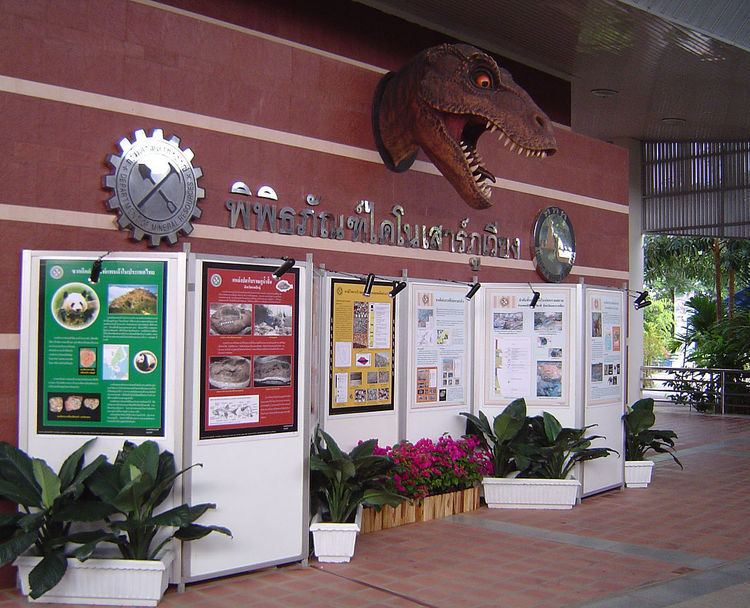Phone +66 85 131 8462 | ||
 | ||
Hours Open today · 9AM–5PMFriday9AM–5PMSaturday9AM–5PMSunday9AM–5PMMondayClosedTuesday9AM–5PMWednesday9AM–5PMThursday(Chakri Memorial Day)9AM–5PMHours might differSuggest an edit Similar Sirindhorn Museum, Si Wiang Dinosaur Park, Phra Mahathat Kaen Nak, Khon Kaen National Museum, Hong Mun Mang Mueang | ||
Phu Wiang Dinosaur Museum (Thai: พิพิธภัณฑ์ไดโนเสาร์ภูเวียง) is a geological museum mainly exhibiting fossils. It is under the administration of the Department of Mineral Resources, Ministry of Natural Resources and Environment, the Royal Thai Government, and situated in the Khok Sanambin public area in Tambon Nai Muang, Wiang Kao district, Khon Kaen province in the northeastern region of Thailand. The museum was constructed with a budget from the Tourism Authority of Thailand under supervision of the Department of Mineral Resources and comprises an area of 40 acres (160,000 m2). It has been open to the public since 2001.
Contents
- Phu wiang dinosaur museum national park
- Thailands first dinosaur discovery
- Expedition and research
- Site development
- Museum origin
- Museum composition
- Dinosaurs from Phu Wiang
- Accessibility
- References
Phu wiang dinosaur museum national park
Thailand’s first dinosaur discovery
Beginning in 1970, the US Geological Survey conducted a mineral exploration in the Phu Wiang area of Khon Kaen province and discovered a type of uranium ore, coffinite, in association with copper ores, azurite and malachite. The International Atomic Energy Agency (IAEA) later joined in. Between 1975 and 1980, the Department of Mineral Resources conducted a detailed drilling program and in 1976 Sudham Yaemniyom, a geologist, discovered a piece of bone on a streambed, Huai Pratu Tima, which was later identified as a distal part of the left femur of a sauropod dinosaur (a large plant-eating dinosaur walking with 4 legs with long neck and long tail), regarded as the first dinosaur discovery of Thailand.
Expedition and research
Since 1976, the Department of Mineral Resources with Thai-French Paleontological Project had continuously investigated the dinosaurs in the Phu Wiang mountains. The project found so many vertebrae, teeth, and footprints of the dinosaurs mainly from sandstone of Early Cretaceous Sao Khua Formation (about 130 million years old) including sauropod and theropod with wide range of sizes from a hen up to a large dinosaur with about 15 meters long. These finds have excited Thai people to make visiting the dinosaur sites as well as Princess Maha Chakri Sirindhorn who visited the site no. 2 on the 3rd of November 1989. Her Royal Highness also visited the second time at the site no. 3 and the Phu Wiang Dinosaur Museum with the committees of the Prince Mahidol International Award, Prince Mahidol Award Foundation under the royal patronage on 25 October 2008.
Site development
After the Phu Wiang National Park had been established in 1991, the Khon Kaen province and Phu Wiang district administrations, the Tourism Authority of Thailand, the Department of Mineral Resources, and other government agencies recognized the importance of the dinosaur sites in the national park. Therefore, the Tourism Authority of Thailand was allocated a budget to develop four dinosaur sites including site 1, site 2, site 3, and site 9, by constructing small buildings covering the sites to protect the dinosaur bones from disturbances, together with walking trails connecting the sites.
Museum origin
Discoveries the dinosaurs on the Phu Wiang mountains was regarded as important discoveries that made much reputation to the Phu Wiang mountains especially the sauropod dinosaur namely Phuwiangosaurus sirindhornae named after Princess Maha Chakri Sirindhorn that Thais and foreigners talk about widely. Some government agencies agree that it had appropriate to build the Phu Wiang Dinosaur Museum and chose the Khok Sanambin public area with an area of 40 acres (160,000 m2) as the place of construction with a budget from the Tourism Authority of Thailand with usage space of 5,500 square meters. The Department of Mineral Resources had been received responsibility in looking after and administration by doing permanent exhibition and opened to public in 2001.
Museum composition
The Phu Wiang Dinosaur Museum has composition in versatile activities including research and investigation section, fossil replication and conservation, fossil collection house, library, permanent exhibition, administration office, and service space such as canteen, souvenir shop, snack and drinks shop, car parking space, and 140-people capacity auditorium. The Phu Wiang Dinosaur Museum is a geological learning source participating various pupils and students from many educational institutes and other agencies such as children learning promotion foundation. The museum has opportunity in welcoming many visitors from both Thais and foreigners.
Dinosaurs from Phu Wiang
Accessibility
The word “Phu Wiang” in the name of the museum results from the fact that the museum used to be located in the Phu Wiang District, though since 2006 it is located in the newly established Wiang Kao district. It is about 80 kilometers to the west of the province capital Khon Kaen.
